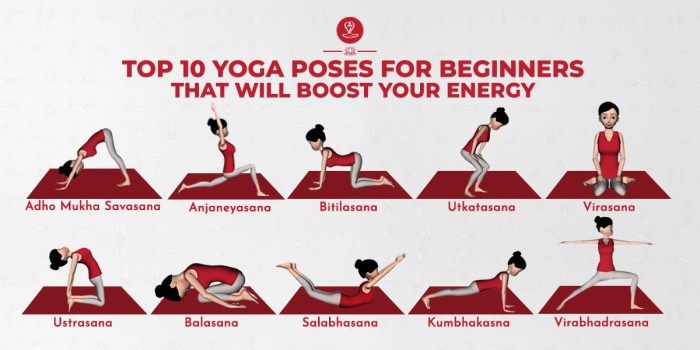Yoga for Beginners takes center stage, inviting you into a world of balance and strength, as we explore the physical and mental benefits, essential poses, and tips to kickstart your practice.
Benefits of Yoga for Beginners
Practicing yoga as a beginner comes with a multitude of benefits that can positively impact both your physical and mental well-being.
Physical Benefits
- Improves flexibility: Yoga helps beginners gradually stretch and lengthen muscles, leading to increased flexibility over time.
- Builds strength: Through various poses and movements, yoga can help beginners strengthen different muscle groups in the body.
- Enhances balance and posture: Practicing yoga can improve balance and posture, which are essential for overall physical health.
Mental Health Benefits
- Reduces stress and anxiety: Yoga promotes relaxation and mindfulness, which can help beginners manage stress and anxiety levels.
- Boosts mood: The combination of movement, breathwork, and meditation in yoga can uplift mood and increase feelings of well-being.
- Improves concentration: Regular yoga practice can enhance focus and concentration, benefiting beginners in various aspects of their lives.
Types of Yoga Suitable for Beginners: Yoga For Beginners
When starting your yoga journey as a beginner, it’s essential to choose a style that is gentle and beginner-friendly. Here are some types of yoga that are recommended for beginners:
Hatha Yoga, Yoga for Beginners
Hatha yoga is a great starting point for beginners as it focuses on basic poses and breathing techniques. It’s a slow-paced practice that allows you to build a strong foundation and improve flexibility.
Vinyasa Yoga
Vinyasa yoga is another excellent choice for beginners as it involves flowing sequences of poses coordinated with breath. While it can be more dynamic than Hatha yoga, it still offers modifications for beginners to adapt the practice to their level.
Yin Yoga
Yin yoga is a gentle and relaxing practice that involves holding poses for an extended period, typically three to five minutes. It’s perfect for beginners looking to improve flexibility and release tension in the body.
Essential Yoga Poses for Beginners

Yoga poses, also known as asanas, are an essential part of a yoga practice. For beginners, it’s important to start with foundational poses that help build strength, flexibility, and balance. Here are some fundamental yoga poses that beginners should start with:
Mountain Pose (Tadasana)
The Mountain Pose is a great starting point for beginners as it helps improve posture and focus.
- Stand tall with feet hip-width apart.
- Engage your core and relax your shoulders.
- Reach your arms down alongside your body with palms facing forward.
- Hold the pose for a few breaths, focusing on grounding through your feet.
Child’s Pose (Balasana)
Child’s Pose is a resting pose that helps calm the mind and stretch the back.
- Kneel on the floor with your big toes touching and knees wide apart.
- Lower your torso between your thighs and extend your arms in front of you.
- Rest your forehead on the mat and breathe deeply into your back.
- Hold the pose for a few breaths, focusing on relaxation.
Downward Facing Dog (Adho Mukha Svanasana)
Downward Facing Dog is a full-body stretch that strengthens the arms, shoulders, and legs.
- Start on your hands and knees, then lift your hips up and back.
- Press into your hands and feet, creating an inverted V shape with your body.
- Keep your knees slightly bent if needed and focus on lengthening your spine.
- Hold the pose for a few breaths, feeling the stretch in your hamstrings and shoulders.
Tips for Starting a Yoga Practice

Starting a yoga practice can be both exciting and overwhelming for beginners. Here are some tips to help you get started on the right foot:
Create a Consistent Yoga Routine
- Set aside specific time slots each week for your yoga practice to make it a priority.
- Start with shorter sessions and gradually increase the duration as you build strength and flexibility.
- Choose a quiet and peaceful space where you can practice without distractions.
Set Realistic Goals
- Avoid comparing yourself to others and focus on your own progress and growth.
- Set achievable goals that align with your current fitness level and lifestyle.
- Celebrate small victories along the way to stay motivated and encouraged.
Find the Right Yoga Class or Instructor
- Research different types of yoga classes and instructors to find the right fit for your needs and preferences.
- Consider trying out a few different classes to see which style resonates with you the most.
- Look for instructors who offer modifications and adjustments for beginners to help you safely learn the poses.
